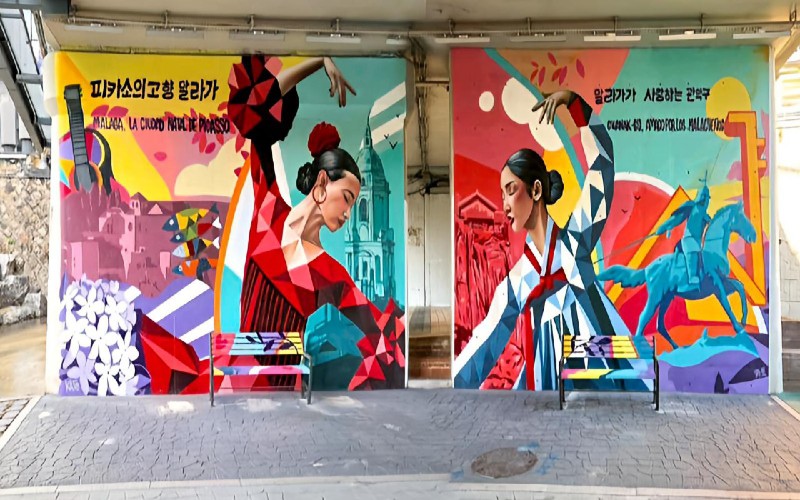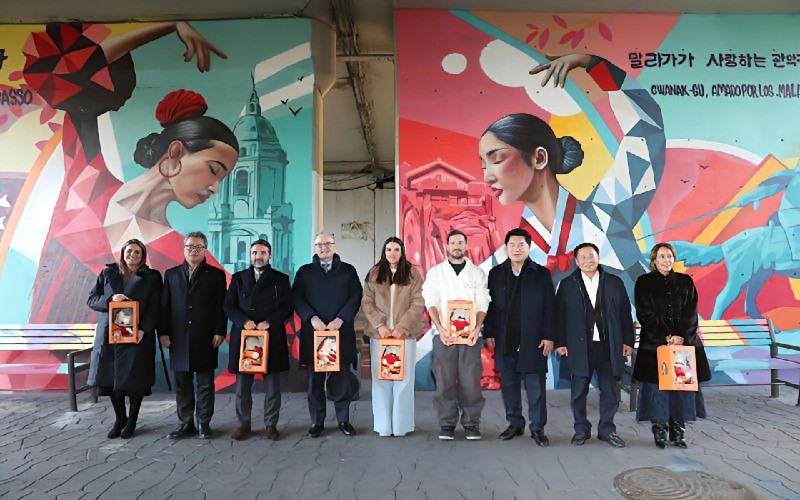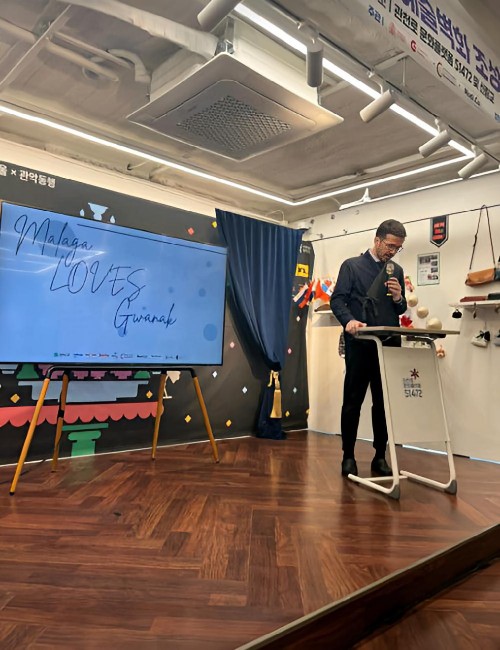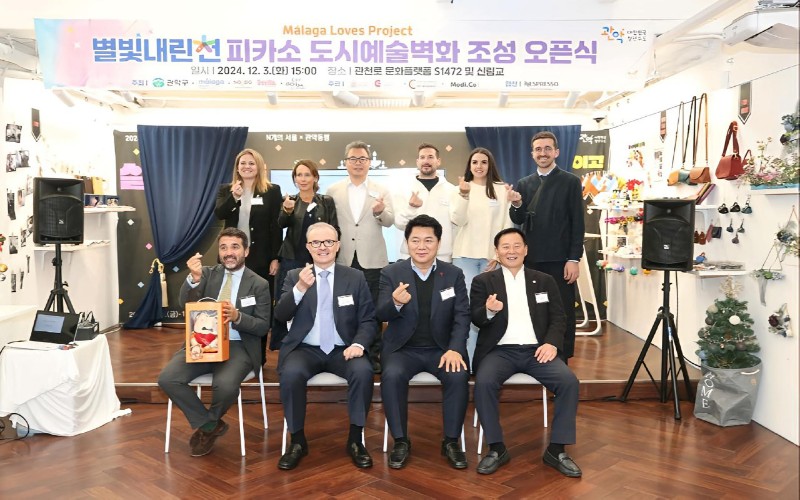
Street art project in Seoul by the artist ‘KATO’ representing relationship between Spain and Korea. (Photo credit by Jiji)
The recent unveiling of a new mural in Seoul's Gwanak District celebrates the cultural connections between Spain and South Korea. This vibrant artwork is part of the ‘Malaga Loves Project’. The concept involves inviting a street artist to create a mural in a public space—specifically along Dorimcheon—blending elements of Korean and Malaga culture with Picasso as the central theme.
It also features motifs that represent Málaga, Picasso, and Gwanak, including landmarks such as Seoul National University (SNU) and General Kang.
In this article I interviewed ‘Jieun Lee’ through email during a period between 26 and 30 of December.
Would you please introduce yourself.
My name is 'Jieun Lee' and my nickname is ‘Jiji’. I have been working as the Secretary General of Spanish Chamber of Commerce in Korea since August 2024. My role involves fostering collaborations and promoting cultural and business exchanges between Spain and Korea.
How did the idea for this specific artwork come about?
This artwork is part of the "Málaga Loves" initiative, a collaborative cultural project led by Málaga Tourism Board. It is an art exchange program connecting Málaga with cities around the world, including Korea. This is the second collaboration with Korea, following the 'Seocho-Gu' mural supported by 'TURESPAÑA'.
The current project in Gwanak-Gu is a collaboration between Gwanak District, Málaga, Spanish Chamber of Commerce in Korea, and Modi (valued member of the Chamber), and highlights the shared heritage and creativity between the two cultures.
What role do you believe art plays in fostering cultural understanding between Spain and Korea?
Art serves as a universal language that transcends cultural boundaries, making it easier to bridge the gaps between two distinct cultures. It allows people to exchange ideas, emotions, and traditions in a way that fosters mutual appreciation and understanding. Through projects like this, both countries can connect on a deeper cultural level.
What significance do the dancers in traditional attire hold in both Spanish and Korean cultures?
This is the idea of the artist ‘KATO’. The dancers symbolise the rich heritage of both cultures. The flamenco dancer, with her Andalusian dress, represents the passion and vibrancy of southern Spain, while the Korean dancer in Hanbok embodies the grace and elegance of Korea’s traditional customs. Together, they highlight the shared value of preserving and celebrating cultural identity.

From the project opening Ceremony in Gwanak. (Photo credit: Jiji)
In what ways does this artwork reflect the historical ties between Malaga and Korea?
I would like to say between Malaga and Gwanak (Seoul) because the artwork reflect the historical ties between both. The wall painting incorporates iconic elements from both Málaga and Gwanak-Gu, illustrating the cultural exchange between the two regions. Málaga is represented through symbols like the flamenco dancer, the Alcazaba (palatial fortification in Málaga), and Picasso's legacy, while Gwanak-Gu features its landmarks like Gwanak Mountain and the statue of General ‘Gang Gam-chan’. The shared elements and the unifying heart-shaped pose of the dancers reflect the spirit of unity and historical ties.
How do the movements of the dancers convey the message of unity and connection?
This is also KATO’s idea. The central pose of the dancers, raising their arms to form a heart, symbolises love and harmony. This gesture visually communicates the idea of connection and mutual respect between the two cultures, reinforcing the theme of cultural unity.
How did you ensure that both cultures were represented authentically in the artwork?
The artwork was carefully designed to incorporate culturally significant elements from both regions. Málaga's essence is captured through its architectural and cultural symbols, while Gwanak-Gu’s heritage is depicted with local landmarks and traditional attire. This meticulous attention to detail ensures authenticity and mutual respect.

‘Juampi Postigo Pich Aguilera’ the MC of this event (Photo credit: Juampi Postigo)
Have there been any events or activities organised around this artwork to engage the public?
We have chosen not to organize additional events or activities specifically for this artwork, as our intention is for people to engage with it naturally. Our goal is for individuals to effortlessly enjoy the artwork during their regular activities, such as jogging, running or walking.
The only formal event we held was the inauguration ceremony which included relevant stakeholders and artists. Additionally, Gwanak District is preparing informational signage to further assist the public in understanding and appreciating the artwork.

Málaga loves project opening ceremony. (Photo credit: Jiji)
What is your favourite aspect of both Korean and Malaga culture that you enjoy sharing with others?
As a Korean, I am deeply familiar with Korean culture, and during my stay in Málaga, I noticed a remarkable cultural similarity centered around the concept of Jeong (정)—a deep emotional bond and sense of affection within communities. This shared value made me feel incredibly welcome in Málaga, and I never experienced loneliness there.
While I cannot claim to know Málaga as intimately as a native Malagueña, my experiences have left me with a profound appreciation for their embodiment of Jeong. It has quickly become one of my favorite aspects of the local culture.
How about this article?
- Like2
- Support1
- Amazing0
- Sad0
- Curious0
- Insightful0


